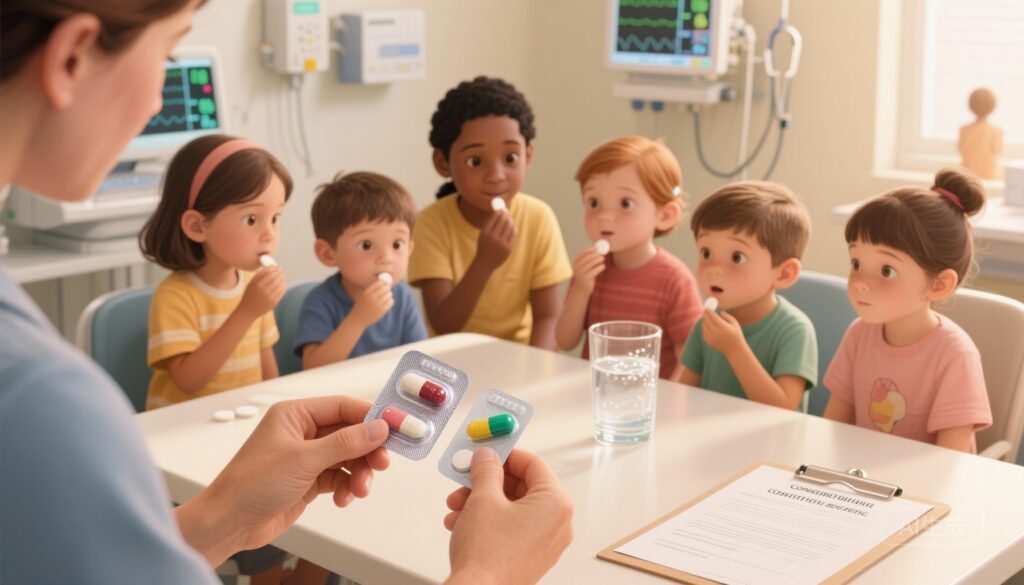Highlights
– A pharmacokinetic (PK) sub‑study nested in the D3/PENTA 21 trial measured intensive 24‑hour PK profiles of dolutegravir (DTG) and lamivudine (3TC) in 72 virologically suppressed children (2–<15 years) switched to once‑daily DTG/3TC fixed‑dose formulations using WHO weight‑band dosing.
– DTG geometric mean (GM) Ctrough 0.82 mg/L and AUC0‑24h 66.2 h·mg/L were achieved, with only three children below the DTG EC90 (0.32 mg/L) but all above the PA‑IC90 (0.064 mg/L); 3TC GM AUC0‑24h was 16.2 h·mg/L.
– Safety was reassuring through 48 weeks: 3 children experienced 4 serious adverse events (SAEs) and 5 children had 6 grade ≥3 adverse events (AEs); none were attributed to DTG/3TC or led to treatment discontinuation.
Background: clinical context and unmet need
Pediatric HIV care lags adult care in options for simplified, tolerable, and low‑pill‑burden antiretroviral therapy (ART). In adults, two‑drug regimens combining dolutegravir (DTG) and lamivudine (3TC) are established alternatives to three‑drug regimens following the GEMINI and TANGO trial programs and are incorporated into many adult treatment guidelines. However, paediatric data on DTG/3TC fixed‑dose formulations remain limited. Children need formulations appropriate for small weight bands (including dispersible tablets for younger children), and regulatory approval requires robust evidence of paediatric pharmacokinetics, tolerability, and safety to ensure exposures are comparable to effective adult/pediatric references.
Study design and methods
The pharmacokinetic and safety sub‑study was nested within the open‑label, multicentre, randomized non‑inferiority D3/PENTA 21 trial (NCT04337450). Eligibility for the sub‑study included children aged 2 to <15 years, virologically suppressed on ART, who switched to once‑daily DTG/3TC fixed‑dose formulations: 5/30 mg dispersible tablets (DT) or 50/300 mg film‑coated tablets (FCT). Dosing followed WHO weight‑band (WB) aligned regimens: 10–<14 kg received 4 DTs; 14–<20 kg received 5 DTs; 20–<25 kg received 6 DTs or 1 FCT; 25–<40 kg received 1 FCT. Intensive 24‑hour PK sampling at steady state (pre‑dose, 1, 2, 3, 4, 6, and 24 hours post‑dose) aimed to obtain ≥8 evaluable PK curves per WB/formulation.
Primary PK endpoints were DTG and 3TC AUC0‑24h and DTG Ctrough (trough concentration). They specifically reported the number of children with DTG Ctrough below the EC90 (0.32 mg/L) and below the protein‑adjusted PA‑IC90 (0.064 mg/L). Safety (clinical and laboratory adverse events) was monitored through 48 weeks in sub‑study participants.
Key results
Population and sampling
– Between 11 May 2022 and 31 May 2023, 82 children consented to the PK sub‑study; 72 contributed evaluable PK profiles. Median age was 7.1 years (IQR 4.9–10.0) and median weight 21.6 kg (IQR 17.7–24.8).
Dolutegravir PK
– DTG geometric mean (GM) Ctrough was 0.82 mg/L (coefficient of variation [CV] 54%), and GM AUC0‑24h was 66.2 h·mg/L (CV 35%).
– Only three children had DTG Ctrough below the EC90 threshold of 0.32 mg/L; importantly, all children had DTG Ctrough ≥0.064 mg/L (the commonly used protein‑adjusted IC90 benchmark).
– The observed DTG exposures were reported to be comparable to historical paediatric PK data from the ODYSSEY trial (DTG pediatric data), supporting that current WB dosing achieves target exposures.
Lamivudine PK
– 3TC GM AUC0‑24h was 16.2 h·mg/L (CV 45%).
– A noteworthy observation: children in the 20–<25 kg weight band taking one FCT (50/300 mg) had a 19% higher GM AUC0‑24h for 3TC than children ≥25 kg taking the same 1 FCT dose, consistent with a higher mg/kg exposure in the lower weight band when fixed tablet dosing is used.
– No 3TC‑related adverse events or laboratory abnormalities were observed in children on the FCT within the 20–<25 kg band.
Safety
– Of the 82 sub‑study participants followed for safety through 48 weeks, 3 children experienced 4 SAEs and 5 children had 6 grade ≥3 AEs. None of these events were attributed to DTG/3TC, and no participant discontinued treatment due to adverse events.
– Overall tolerability was good, and no new safety signals were identified compared with known profiles of DTG and 3TC.
Comparative context
– The authors report that the PK parameters measured were comparable to historical paediatric cohorts (ODYSSEY for DTG and IMPAACT2019 for 3TC), lending further confidence that the formulations and WB dosing yield exposures in the expected therapeutic range.
Interpretation and clinical implications
This sub‑study provides pharmacokinetic and safety evidence supporting the use of once‑daily fixed‑dose DTG/3TC dispersible and film‑coated tablets in children aged 2 to <15 years, dosed according to WHO weight bands. Key clinical implications include:
– Target exposure: DTG exposures exceeded commonly accepted efficacy thresholds (EC90) in the large majority of participants; all participants had concentrations above the conservative PA‑IC90 reference, suggesting robust antiviral activity potential.
– Fixed‑dose pragmatic dosing: WB‑aligned fixed tablet dosing simplified administration, and dispersible formulations enable use in younger children unable to swallow tablets.
– Safety: short‑term (48‑week) safety was reassuring — no drug‑related SAEs or discontinuations — supporting tolerability in a real‑world pediatric population.
– Regulatory support: the findings provide pharmacologic and safety data that may underwrite regulatory submissions for pediatric labeling of these DTG/3TC formulations.
Expert commentary: strengths, limitations and open questions
Strengths
– Intensive 24‑hour PK profiling at steady state across multiple weight bands gives a robust characterization of exposure for both formulations.
– Inclusion of dispersible and film‑coated tablets addresses practical formulation needs across pediatric ages and developmental stages.
– The nested design within a randomized trial provides clinical context and systematic safety follow‑up.
Limitations and considerations
– Sample size within some weight‑formulation strata may be small; while PK targets were met overall, rare subgroups could be underpowered to detect outliers.
– The sub‑study enrollment included virologically suppressed children switching therapy; hence these PK and safety data apply to switch populations and may not fully substitute for treatment‑naïve efficacy trials in children.
– The study did not evaluate long‑term clinical outcomes beyond 48 weeks or the impact of intercurrent illnesses, malnutrition, or important drug–drug interactions (e.g., concomitant rifampicin for tuberculosis) that can alter DTG exposures and may require dose modification.
– Although DTG Ctrough values were overwhelmingly above EC90, three children had Ctrough <0.32 mg/L. The clinical relevance of transient or modestly lower troughs is unknown but worth monitoring, particularly in adherence‑challenged contexts or with resistance‑related concerns.
Mechanistic and pragmatic insights
– The observed higher 3TC exposures in the 20–<25 kg band when given a single 50/300 mg film‑coated tablet reflect the pragmatic trade‑offs of fixed‑dose tablet strategies: simpler dosing but variable mg/kg exposures at weight‑band boundaries. The clinical significance of a 19% higher 3TC AUC is likely small given 3TC's wide therapeutic window, but it underscores the need to monitor weight‑band transitions and to continue to evaluate safety and tolerability in routine care.
Where this fits with existing evidence
DTG/3TC as a two‑drug regimen has proven efficacy in adults and is now an established alternative to three‑drug regimens for many patients. This pediatric PK and safety data help close the evidence gap for children by demonstrating that commonly used pediatric weight‑band dosing of dispersible and film‑coated DTG/3TC achieves target exposures and is well tolerated in the short to medium term. These results complement larger efficacy and safety trials in adults and paediatric exposure data from historical trials referenced by the authors (ODYSSEY, IMPAACT2019).
Conclusions and research priorities
The D3/PENTA 21 PK sub‑study provides robust, clinically relevant evidence that once‑daily DTG/3TC fixed‑dose dispersible and film‑coated tablets deliver adequate DTG and 3TC exposures across WHO weight bands in children 2–<15 years, with a reassuring safety profile through 48 weeks. These findings support regulatory filings and wider implementation of DTG/3TC pediatric formulations, particularly where simplifying regimens and reducing pill burden are priorities.
Remaining priorities include:
– Continued follow‑up for longer‑term virologic efficacy, resistance surveillance, and safety beyond 48 weeks in diverse global paediatric populations.
– Evaluation of drug–drug interaction strategies (notably with rifampicin for TB co‑infection) and dosing recommendations in presence of interacting medications.
– Operational research on formulation availability, supply chain, and caregiver education to maximize adherence and safe weight‑band transitions.
Funding and trial registration
The D3/Penta 21 trial is sponsored by Fondazione Penta Onlus ETS (Penta) and funded by ViiV Healthcare. Trial registration: NCT04337450.
References
Bevers LAH, Toledo G, Kisekka M, et al.; D3 TRIAL TEAM. Once‑daily dolutegravir/lamivudine fixed‑dose formulations in children living with HIV: a pharmacokinetic and safety sub‑study nested in the open‑label, multicentre, randomised, non‑inferiority D3/PENTA 21 trial. EBioMedicine. 2025 Oct;120:105929. doi: 10.1016/j.ebiom.2025.105929. Epub 2025 Sep 26. PMID: 41014973; PMCID: PMC12509724.
World Health Organization. Consolidated guidelines on the use of antiretroviral drugs for treating and preventing HIV infection (updated guidance 2021). WHO: Geneva. (Guidance on pediatric weight‑band dosing and DTG use in children.)
ODYSSEY trial (paediatric dolutegravir exposure data) — referenced as historical pediatric comparator in the sub‑study.
IMPAACT2019 (paediatric lamivudine exposure data) — referenced as historical pediatric comparator in the sub‑study.
(Notes: Additional pivotal adult trials and guideline documents support DTG/3TC as a two‑drug regimen in adults. For specific adult and pediatric guideline statements, readers should consult WHO consolidated guidelines and national HIV treatment recommendations.)



